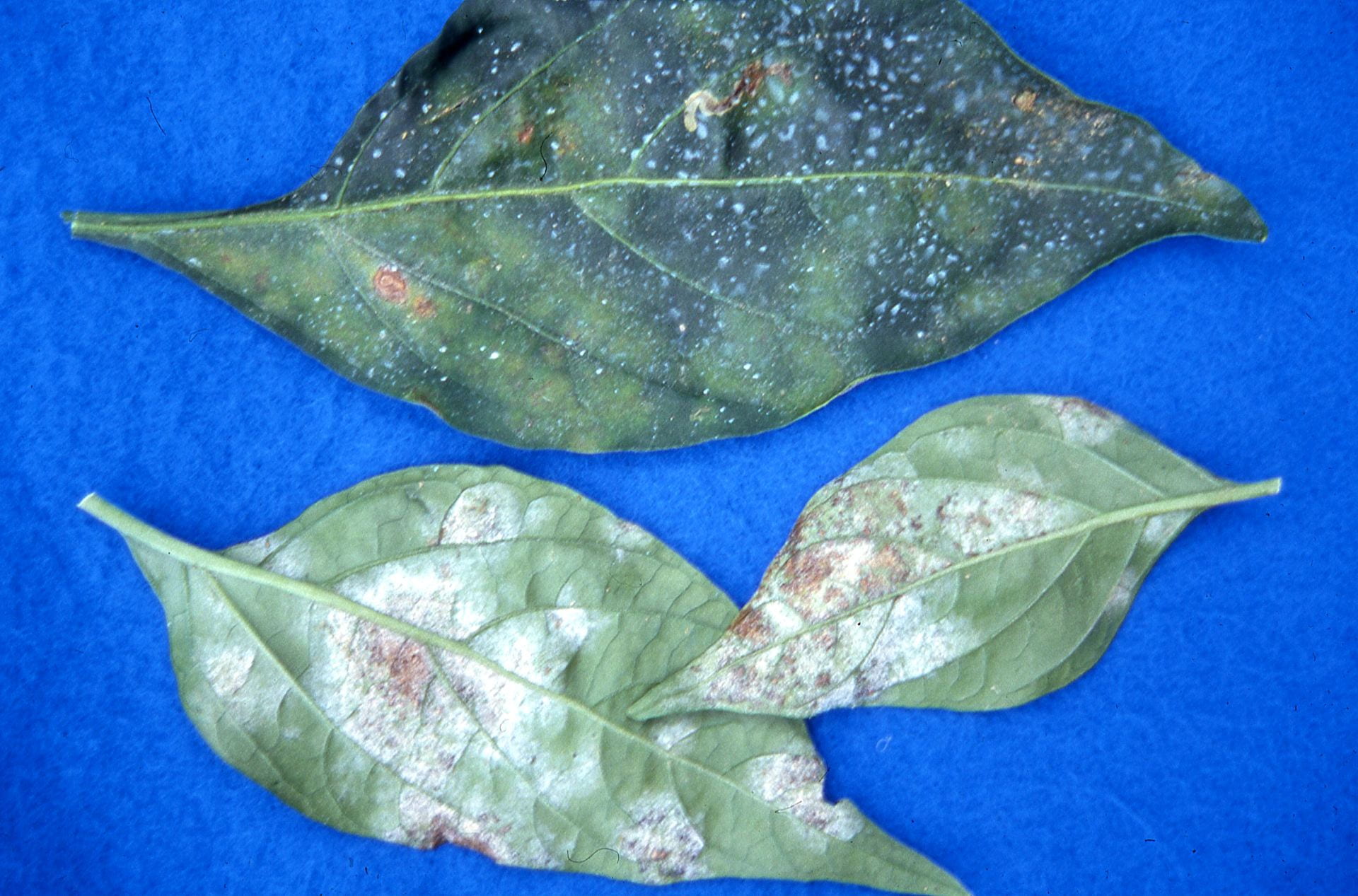Powdery mildew has been observed three times on pepper in New York. It was found in western NY in August 1999 and on Long Island, NY, in August 2000 and July 2008. This is a relatively new disease in North America. Concern that it could become in the northeastern U.S. has fortunately not been realized. It has become an important problem in California and also occurs in Florida, but environmental conditions in production areas there differ from those in the northeast.
Powdery mildew of pepper is caused by Leveillula taurica, which is a very different powdery mildew fungus from that causing powdery mildew on cucurbits (Podosphaera xanthii, formerly known as Sphaerotheca fuliginea) and powdery mildew on tomato in the northeast (Oidium lycopersicum). Podosphaera xanthii and Oidium lycopersicum grow on both surfaces of a leaf and form haustoria within some epidermal cells to absorb nutrients. They produce spores on both surfaces. In contrast, Leveillula taurica grows only within a leaf until it produces spores, a growth habit which is similar to Alternaria and most other foliar plant pathogenic fungi. Additionally, Leveillula taurica only produces spores on the underside of leaves (see picture). Leveillula taurica is a species complex that infects over 1000 plant species in 74 families, including tomato and eggplant as well as pepper.
Detecting powdery mildew on pepper can be difficult. The white powdery growth characteristic of powdery mildew diseases occurs only on the underside of leaves (see picture) and it will turn brown rather than remaining white. Diffuse yellow spotting often develops on the upper surface. Affected leaves tend to drop off the plant, as occurs with bacterial leaf spot.
Powdery mildew of pepper was first reported in North America in 1971 when it was seen in southwest Florida. It was first reported in Puerto Rico in 1992, in Idaho on greenhouse-grown pepper in 1998, in North-Central Mexico in 1998, and in both Canada and Oklahoma on greenhouse-grown pepper in 1999. It has not been seen in Georgia, Connecticut, Massachusetts, New Jersey, North Carolina, or Ohio. This disease has been a recurring problem on both chili peppers and bell peppers in all production districts in California since the early 1990s. The same pathogen also attacks tomato in California. It was found in all the major tomato-growing regions of California during a survey in 1983-85 on tomato, pepper, cotton, globe artichoke, onion and 6 weeds. Presently, it is considered a problem on tomatoes and/or peppers in California, Arizona, Utah and Nevada.
The first two sightings of powdery mildew on pepper in NY were in commercial production fields planted with transplants from both Georgia and Florida. Symptoms were observed on all cultivars of bell and chili pepper in the Long Island field, but not on tomato and eggplant in adjacent rows. Powdery mildew was not found in nearby commercial fields examined after these two sightings. This new disease was not found again in 2000 at the farm where it occurred in 1999. Powdery mildew occurs on pepper in Florida, suggesting that the pathogen could have been on the transplants. Symptoms were found on field-grown peppers in the Florida transplant production area in April 2001 at the time that transplants were being produced for New York. Considering the time from infection to first symptoms (the latent period) is 18 to 21 days, and symptoms tend to be subtle initially, diseased seedlings could easily go undetected. The last occurrence was on plants of Islander which the grower produced himself; a potential source of the pathogen could not be determined.
Symptoms of powdery mildew on upper leaf surface (faint yellowing) and lower surface (characteristic powdery growth of pathogen) of pepper leaves in Aug 2000 (first) and July 2008 (second).
More information/prepared by:
Margaret Tuttle McGrath
Associate Professor Emeritus
Long Island Horticultural Research and Extension Center (LIHREC)
Plant Pathology and Plant-Microbe Biology Section
School of Integrative Plant Science
College of Agriculture and Life Sciences
Cornell University
mtm3@cornell.edu




